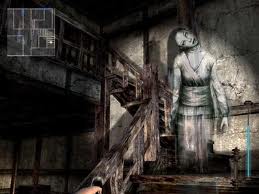
The Himuro Mansion (or Himikyru Mansion) is a japanese urban legend
about the dark history of a haunted house and the horrible murders of
an entire family who lived there. They say that the video game Fatal
Frame was based on a true story. Eager to solve the mystery, many people
have scoured maps, trying to find the real location of Himuro Mansion.
According to the legend, the Himuro Mansion is a large, traditional
Japanese house that is located in a rocky area somewhere on the
outskirts of Tokyo. The mansion became famous for being the site of the
worst mass murder in the history of Japan.
Terrible rituals were performed deep in Himuro Mansion, such as
the Strangling Ritual, the Demon Tag Ritual, and the Blinding Ritual.
The Strangling Ritual and Blinding Ritual were performed in a hidden
room, not shown on the house's original plans. This room is connected to
the house by a long lattice corridor that starts at the Rubble Room.
These rituals were part of the Himuro family's duty to keep the Hell
Gate sealed. The family was able to do this for many years until Kirie's
ritual failed and caused The Calamity, killing most of the occupants of
the mansion and unleashing the Malice, cursing the mansion and all who
die within it. The Himuro Family Master then killed all those in the
house who survived The Calamity before taking his own life.
A
folklorist named Ryozo Munakata moved in with his family to study the
mansion, but he and his family disappeared, killed by the mansion's
curse. Years later, Junsei Takamine and his research team went to
investagte the masion for Takamine's newest work and disappeard, leading
Mafuyu Hinasaki to the masion in search of them, where he too
disappeared. His younger sister, Miku Hinasaki, then arrives at the
mansion and breaks the mansion's curse to rescure her brother.
The Himuro family were said to have practiced ancient and
forgotten Shinto rituals that had long ago been outlawed in Japan. One
of these occult rituals was called “The Strangling Ritual” and involved
the sacrificial murder of a young girl. The purpose of this
gruesome ritual was to protect the Himuro family from bad karma which
they believed would emerge from a portal in the mansion’s courtyard.
Himuro Mansion Haunting - Urban Legend of Haunted House & Horrible Murders
Please Don't Touch - Unless You Want a Baby!
More than 2,000 women have reported that they became pregnant shortly after touching the wooden fertility statues.
Many of them had been told by doctors they would never be able to
conceive. Some are very serious about touching the statues, believing in
their powers to help them conceive. Others want to avoid touching the fertlity statues
- for the very same reason! The five-foot tall wooden statues were
acquired from the Ivory Coast of West Africa in 1993 and were placed in
the lobby of Ripley Entertainment's corporate headquarters in Orlando.
Within months, 13 women, including staffers and office visitors were
pregnant.
A Little History
The five foot tall wooden statues were acquired from the Baule people of
the Ivory Coast of West Africa and within a year of going on display at
Ripley Entertainment’s head office in Orlando, Florida, 13 office staff
and visitors became pregnant.
The
idea of fertility statues appear in a variety of cultures. Fertility
statues serve both as a tribute to whatever fertility gods that the
locals believe in, as well as often a mystical totem which helps the
women of a given tribe to conceive and bear healthy children. These
fertility statues may resemble people, or they can look like some
particular animal that is associated with fertility in that culture.
Archaeological digs have turned up a variety of these sorts of statues,
from the Norse goddess Freya riding a boar to the statue of a fat woman
found in the ruins of the Tarxien temples on the island of Malta.
The Legend of the African Fertility Statues
 |
|
According to legend, Pope Joan was a woman who concealed her gender and
ruled as pope for two years, from 853-855 ad. Her identity was exposed
when, riding one day from St. Peter's to the Lateran, she stopped by the
side of the road and, to the astonishment of everyone, gave birth to a
child.
Pope Joan was a legendary female Pope who allegedly reigned for a few
years some time during the Middle Ages. The story first appeared in
13th-century chronicles, and was subsequently spread and embellished
throughout Europe. It was widely believed for centuries, though modern
religious scholars consider it fictitious, perhaps deriving from
historicized folklore regarding Roman monuments or from anti-papal
satire.
The first mention of the female pope appears in the chronicle of Jean de
Mailly, but the most popular and influential version was that
interpolated into Martin of Troppau's Chronicon Pontificum et
Imperatorum, later in the 13th century. Most versions of her story
describe her as a talented and learned woman who disguises herself as a
man, often at the behest of a lover. In the most common accounts, due to
her abilities, she rises through the church hierarchy, eventually being
elected pope. However, while riding on horseback, she gives birth, thus
exposing her gender. In most versions, she dies shortly after, either
being killed by an angry mob or from natural causes. Her memory is then
shunned by her successors.
Mysterious Woman Pope Who Just Won't Go Away
At the start of the last week’s Quilt Walk, some curtains appeared to have been moved at the Lake City-Columbia County Museum, 157 SE Hernando Ave.
This is not earth-shattering news, but it harkens back to stories of a ghost in the house. Some past and present museum docents give credit to such incidents to a former resident of the house.
“Cora has been here,” said Museum President Pat McAlhany said as she pointed to the curtains. She then told the story of the museum’s ghost.
Whether moving curtains, plates or an extremely heavy bookcase is supernatural or just physics of an old structure can be debated until the end of time. For some individuals, however, these occurrences are the work of a particular spirit.
The majority of the house where the museum sits today was built in the late 1870s, McAlhany said. There was a young lady named Cora Vinzant who was from High Springs. She stayed with family members in the house while she attended Lake City Institute.
“The night before she was to graduate,” McAlhany said, “Cora died from yellow fever.”
Vinzant died on May 26, 1892, according to an original hand-carried announcement of the day, which is at the museum in a scrapbook.
Opening curtains in one room on the second floor of the museum at some time between the night of March 26 and the morning of March 27 is among the less spectacular feats attributed to Cora.
The ghost is given credit for moving very heavy furniture too.
Four people left the museum at 9 p.m. on the Thursday before the 2008 Quilt Walk, McAlhany said. They returned at 8 a.m. on Friday.
In those 11 hours, a bookshelf with 300 books on it somehow had moved to another room and was sitting at a 45-degree angle, Karen Cross said. She was among those who discovered it.
“And there were no scratches on the (wooden) floor from it being moved,” Cross said, “until two of us moved it back.”
Jerry Horton said Cora gave him a start a few weeks ago.
“I was showing a visitor this display case,” Horton said. “This Bible here went in slow motion and fell face down. It was May Vinzant’s Bible. She lived here from 1881 until 1981. She died at the age of 102 or 103.”
That Bible was sitting on a carrier similar to those used for placing collectible baseballs, so they will sit on a shelf.
That same glass display case offered another opportunity for Cora to exhibit a prank, McAlhany said.
One day, there were four people sitting in the same room as the dispay case, she said. Its door four times, with a person having closed it each time. There was no person walking on the outside porch or making enough movement in the room or the house to shake the floor.
Read complete story at http://www.lakecityreporter.com/articles/2009/04/05/community/life/doc49d586a76196d085711916.txt



